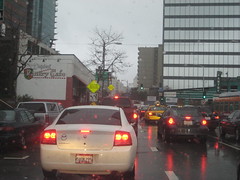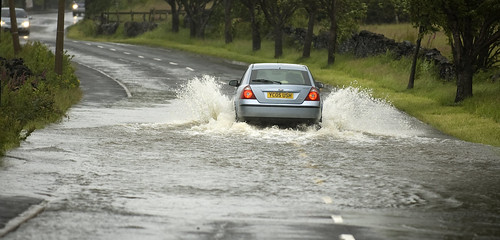Rainy Day Driving Tips That Can Help Your Fuel Economy

So here are a few rainy day driving tips that could not only help you stay safe on the road, but could potentially improve your fuel economy in the rain as well:
1) Quick acceleration and/or breaking fast can reduce your fuel economy by up to 33% on the highway. With slick roads and sometimes poor visibility due to rain, a good tip is to slow down and give a little more room between you and the vehicle in front of you. Your vehicle does not react the same on a dry road as it does on a wet road, so you’ll need to compensate for the difference.

3) Ensure your tires are in good condition. Worn out tires have shallow grooves and don’t provide the type of traction you need when driving in the rain. Improperly inflated tires can wear your tires down faster and affect your ability to maneuver on wet roads. Plus…don’t forget, tires can lose up to a pound of pressure for every 10 degree drop in temperature. And unaligned tires can create unneeded friction while driving and this too can cause tires to wear out and lower fuel economy.

Basically, when it all comes down to it, your vehicle and fuel economy are not the same in dry conditions as they are in wet, rainy conditions. You must factor that in when driving in the rain. So before you head out for work, school, errands, etc. brush up on your “Tips for Driving in Rain” so you can have a safe and happy drive!
6 Comments
-
LoveEarthAlways.com
Good points for younger drivers too. I remember my father telling me to drive like I had an egg under my gas pedal foot. Now that I am paying my gas bills, that is how I tend to drive. Wet pavement and black ice this time of year make it all the more important to take it easy on the roads.
-
Ashely Perine
I cannot describe how refreshed I am to read and reccomend your post. Its superbly composed and carries quality info. carry on the good work!
-
Cape Cobras
Thank you for this nice tips. I feel like shouting each one of them off the roof of a very tall building. I am surprised how many drivers just do not adjust their speed and driving habits to fit the hazardous driving conditions. It is very frustrating and puts all drivers and passengers on the road at even more risk.
-
Marlon
Driving is very stressful when you have limited visibility, so do everything you can to increase your visibility especially at night, during fog, and during rain.


Stephanie
Great tips – the rate of accidents always increases during inclement weather. I always add in at least an extra 10-15 minutes so I don’t have to rush around in the rain. Drive safely!